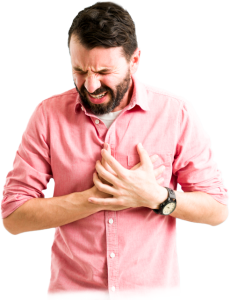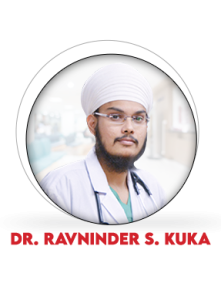Winters in north India bring with them foggy mornings, numerous cups of hot beverages and munching on high calorie snacks. But enjoying the weather does not mean neglecting one’s health and a few simple measures can save heart patients a trip to the hospital. Cold weather makes the heart work harder to keep the body warm, so heart rate and blood pressure may increase. These changes can cause heart problems, especially if one already has a heart condition.
What is heart failure?
Heart failure (HF), often referred to as congestive heart failure (CHF), occurs when the heart is unable to pump enough blood, causing it to work harder to deliver the blood to the body. However, it doesn’t mean that heart has stopped working altogether. The prevalence of HF increases with age. Heart disease is the number one killer worldwide accounting for nearly one-third of all global deaths.
The most common symptoms of heart failure are shortness of breath, swelling in the legs and feet, weakness, increase in heart rate and dizziness. Risk factors include smoking, high blood pressure, high cholesterol, diabetes, family history, and obesity.
If treated at an early stage, heart failure is reversible most of the times. But if fully established, it is progressive and can be fatal. However, with lifestyle modification, diet and regular exercise, most patients can lead a near normal life and remain stable with regular follow up with a cardiologist.
The patients with heart failure are prone to hospitalizations due to worsening of symptoms periodically. Long term treatment is required to prevent and reduce these potentially life threatening acute flare-ups. With the onset of winters, there is an increase in the hospitalization of patients with heart failure. A drop of 10°C in the average temperature over seven days is associated with an increased risk of being hospitalized or dying of heart failure in about 7% in people aged over 65 years with the disease.

How cold affects heart failure?
- When the body is suddenly exposed to icy temperatures, blood vessels clamp down. This causes the heart to beat faster to keep the body warm, while the body simultaneously tightens its arteries in response to the cold. This decreases heat transfer via the skin- causing an increase in blood pressure.
- Winters lead to increase in respiratory infections especially Influenza. Chest infections can lead to worsening of heart failure symptoms.
- Increase in fog and air pollution leading to dense smog close to the ground causes breathing problems.
- Lack of sweating in winters combined with increased blood pressure may lead to haccumulation of excess fluid in limbs or in the lungs, leading to increased workload on the heart and thus, heart failure.
- Dietary factors like high fat diet and lack of vitamin D can precipitate heart failure.
- Rigorous physical activity in the cold leads to increased load on the heart. However, total lack of physical activity is also bad for heart failure patients as it can lead to clotting problems.
How to prevent?
- Avoidance of extremely cold temperature is advised. Do not go out for walks in very cold weather. Avoid working outside in the cold. Staying active indoors can help keep you warm. Move around at least once an hour and avoid sitting still for long periods.
- Wearing a few thin layers can help keep one warmer than one thick layer. A lot of heat is lost from the head, so wear a hat and scarf when going outside.
- Try to avoid getting the flu by washing hands often with soap and water and avoiding contact with flu patients. Before the onset of the season, influenza & pneumonia vaccines should be taken to prevent chest infections.
- Avoid missing your doctor’s appointments due to the weather and do not miss a dose of prescribed medicine. In winter months, it’s best to have a supply of medication large enough so that it won’t run out if there’s rough weather.
- Avoid overindulging at parties by eating a light, healthy meal before you go to reduce your appetite for unhealthy food; using smaller plates; limiting your alcohol intake.
- Regular monitoring of fluid intake, urine output, blood pressure, kidney function and lung function should be done and if any abnormality is detected it should be managed accordingly. This paper review seasonal patterns across twelve cardiovascular diseases: Deep venous thrombosis, pulmonary embolism, aortic dissection and rupture, stroke, intracerebral hemorrhage, hypertension, heart failure, angina pectoris, myocardial infarction, sudden cardiac death, venricular arrythmia and atrial fibrillation, and discuss a possible cause of the occurrence of these diseases. There is a clear seasonal trend of cardiovascular diseases, with the highest incidence occurring during the colder winter months, which have been described in many countries. This phenomenon likely contributes to the numbers of deaths occurring in winter. The implications of this finding are important for testing the relative importance of the proposed mechanisms. Understanding the influence of season and other factors is essential when seeking to implement effective public health measures.Keywords: Cardiovascular diseases, Periodicity, Seasons
- Weight should be closely monitored. If there is an increase of more than 1 kg over a period of 3 days, it could indicate that the body is retaining water either in the legs or the lungs.
- Having regular hot meals and drinks to give your body the energy it needs to keep warm
A very close attention needs to be given to changes in symptoms, which can reduce the chances of visiting the hospital.It is important to recognize small changes in daily health that can lead to early treatment and better quality of life, be it winter, summer or autumn.

Our Expert
Dr Ravninder Singh Kuka is Assistant Director and Senior Consultant of Interventional Cardiology at SPS Hospitals, Ludhiana. He has an experience of 10 years in dealing with cardiac patients and doing intervention in cases of Coronary Artery Disease and Peripheral Arterial disease. Apart from routine interventions like coronary angiography, coronary angioplasty and permanent pacemaker insertion, he also performs complex coronary interventions like left main angioplasty and bifurcation angioplasty, peripheral artery angioplasty & embolization, targeted thrombolysis and thrombectomy and electrophysiology procedures like left bundle branch pacing. He also does device closure of atrial septal defect & PDA in adults. He is trained for advanced heart failure therapies like cardiac resynchronization therapy. He also performs valvular interventions like balloon mitral valvotomy, pulmonary valvotomy. He is well trained for carotid interventions like carotid angioplasty.

Leave a Reply